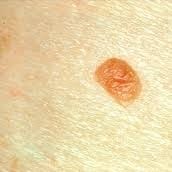What Is A Mole?

What Are Moles?
The term mole is very widely used and includes very easy to remove skin tags as well as soft naevuses and other skin lesions. Commonly, moles are darker than the surrounding skin Classically, Moles are small patches on the skin, which can be flat or raised, that form due to collections of cells called melanocytes. Melanocytes produce the colour (pigment) in your skin. The scientific name for moles is melanocytic naevi.
Moles are often a brownish colour, although some may be darker or skin-coloured. They can be flat or raised, smooth or rough, and some have hair growing from them. Moles are usually circular or oval with a smooth edge.
Moles can change in number and appearance. Some fade away over time, often without you realising. They also sometimes respond to hormonal changes, for example during:
- pregnancy – when they may get slightly darker
- teenage years – when they increase in number
- older age – when they may disappear from 40 to 50 years of age onwards
When Do Moles Develop?
Some moles are present at birth, however most moles develop during the first 25 – 30 years of life. People with fair skin often have more moles than people with darker skin. Most moles have a genetic cause and are inherited, this is often the case with people who have a lot of moles. Where you were brought up may also make a difference, for example, if you have spent a lot of time in the sun, you may have an increased number of small moles.Harmless Moles
Most moles are completely harmless. However, they may be unsightly and affect your confidence. Moles can also be a nuisance, for example if they regularly catch on your clothing or you cut them while shaving. These moles can be surgically treated and at Thames Valley Surgical Services, we can remove these moles for you.
Mole Removal Surgery
Prior to any surgery your skin will be numbed. Depending on size or location of your mole Dr Kittel can just shave the mole off so that it is level with your skin. This is known as a shave excision. The wound may then be closed with heat during a process called cauterisation. Another option for skin surgery is to do a small excision, which leaves a thinner, but longer scar.
Cost of Mole Removal Surgery: £225*
*The cost of Mole removal Surgery starts at £225 for a shave excision. Click here for more detailed pricing. Please be aware laboratory cost and consultation are charged separately and the above price plus the consultation is £285.The consultation is free for returning customers. Lesions in the face are more expensive.
How Will I Know It’s Not Cancer?
At Thames Valley Surgical Services we take great care of your moles. Every mole will be sent to a lab for a medical lab for complete peace of mind. We never remove skin cancers. If we feel a lesion may be skin cancer we will refer you swiftly to a hospital based team specialising in skin cancer. However, we specialise in the cosmetic removal of moles.
What next?
If you wish to make an appointment you can contact us or book an appointment online. Alternatively you can ask for a telephone consultation. If you do so, please read the section “How TVVS works”, thoroughly. If you are worried about pain, please click here to see how we provide painfree surgery.
How Do I Check My Skin?
You should check your skin every few months for any new moles that develop (particularly after your teenage years, when new moles become less common) or any changes to existing moles. A mole can change in weeks or months.
Things to look for include:
- moles with uneven colouring – most moles only have one or two colours, but melanomas have lots of different shades
- moles with an uneven or ragged edge – moles are usually circular or oval with a smooth border
- bleeding, itching, red, inflamed (swollen) or crusty moles
- moles that get a lot bigger – most moles are no bigger than the width of a pencil
A helpful way to remember what to look for is to use the ABCDE method.
- A – asymmetry
- B – border irregularity
- C – colour change
- D – diameter
- E – elevated (raised) or enlarged
Moles like this can occur anywhere on your body, but most happen on the back, legs, arms and face.
If you notice any changes to your moles or are worried about them, see your GP. Changes to a mole may be an early indication of a type of skin cancer called melanoma.
More Information: For a glossary on minor surgery terms, click here
We provide Minor Surgery / Skin Surgery for Lipomas, Cysts, Warts, Moles, Skin Tags, Xanthelasmas and Split Earlobes in Maidenhead, Berkshire, which is near Windsor and Ascot and Heathrow Airport and close to London, South Buckinghamshire, South Oxfordshire, Hampshire and Surrey. TVSS are adjacent to Henley-On-Thames, Marlow, and Twyford. Also, we are close to Slough, Bracknell, Basingstoke, Egham and Gerrards Cross. Chalfont St Peter, Northolt, Harrow and Wembley. Rickmansworth, Richmond, Twickenham, Staines and Virginia Water. Sunningdale and Sunninghill, Ruislip, Reading, Wokingham and West Drayton. Uxbridge, Farnborough, Woking, Guildford. Oxford, Banbury, Milton Keynes and Coventry. Essex, Sussex, Kent, Swindon, Portsmouth and Bristol, Bath, Brighton, Eastborne and Southhampton are all no more than an 45 minutes to 2 hours away. Via the M4 we are also accessible to certain locations in South Wales
